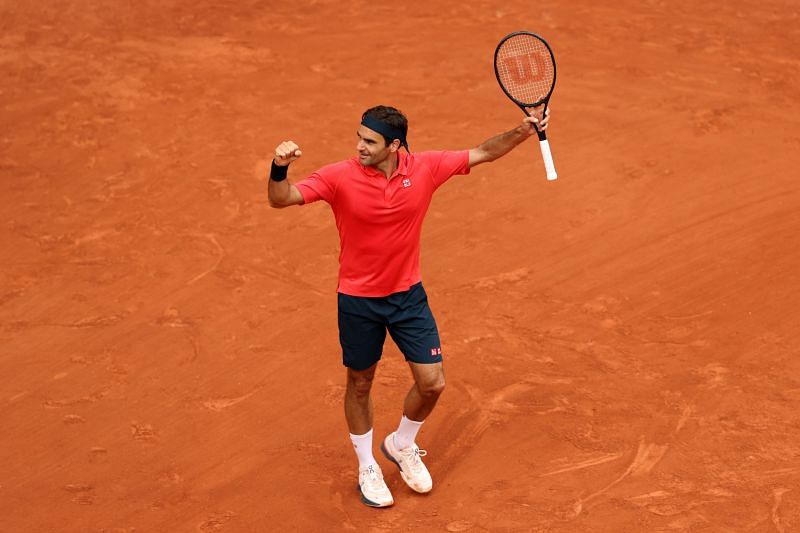
Analyzing the GOAT race from the perspective of Roger Federer, Rafael Nadal & Novak Djokovic's single-season dominance
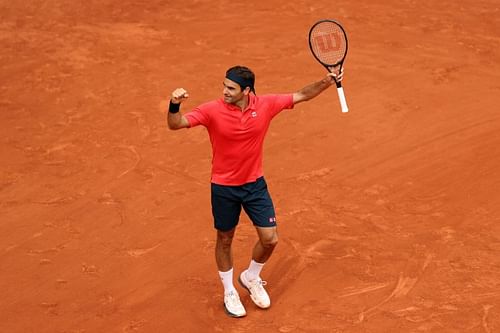
What would you say was Rafael Nadal's best season? Was it 2008, when he won 82 matches, or 2013, when he scored 13,030 points (the most he has done in his entire career)?
What about 2010, the only year in which the Spaniard won three Grand Slams? Does 2018 also get a vote, given he lost just four matches out of 49?
Perhaps the vast majority of people will lean towards 2010 or 2013. So is it fair to assume that observers are drawn towards either superior Grand Slam performances or a series of great results that lead to the accumulation of the most ranking points?
The GOAT debate involves a lot of different parameters, and dominance over a specific period (either a season, or something a little longer than that) is often taken as an important point. So who among Roger Federer, Rafael Nadal and Novak Djokovic has the edge in this regard?
The best stretch of seasons

The concept of comparing individual seasons isn't something new. The fans like to dwell on their favorite player's peak seasons, but they also have a tendency to compare them with those of another player.
But what if we expanded the idea to accommodate for a stretch of seasons? Let's take two 10-year periods of Novak Djokovic for example:
1. 2007-2016: Djokovic won 698 matches at a win-rate of 85.02%. In the process, he racked up 1,10,019 career points and 64 titles, 12 of which were Grand Slams.
2. 2011-2020: Djokovic won 630 matches at a win-rate of 87.52%. In the process, he racked up 1,05,275 career points and 63 titles, 16 of which were Grand Slams.
The overall difference boils down to two four-year periods: 2007-2010 and 2017-2020. While Novak Djokovic won four fewer Grand Slams in 2007-2010, he still accumulated nearly 5000 more points in that period.
That difference was majorly influenced by an additional runner-up finish and five more semifinal runs at Grand Slams, plus an ATP Finals title.

While the figures are staggering in both cases, most people would choose the 2011-2020 period because of the Grand Slam titles. And that begs the question - can the worth of winning more Majors be compensated by performances at lower levels, or even by other results at the Grand Slam level? If yes, then what formula can be used to calculate the numbers required for such a compensation?
The index
Before arriving at that formula, we first have to establish an index to adjust the existing system of ranking achievements by ranking points. The index clubs certain ranking results into a category, and assigns points to those respective categories.
Here's how the index looks:

The most salient feature of the index is that Grand Slam titles have greater weight here than they do in the ATP ranking structure. As for the Olympics, though they were worth only 750 points in 2012 (and scaled to 800 prior to that), an argument can be made that they are at least as important as the Masters (if not more). Hence, they both the Olympics and the Masters have been assigned 30 points.
600, 450 and 350 titles are those that, prior to the current system (which was introduced in 2008), were worth 300 points, 225 points and 175 points respectively.
Note: The career points used in this study have been kept consistent with those here. Team events have been excluded, and all results up to the completion of Roland Garros 2021 have been taken into account.
The role of win percentage

Not every win has the same weight. Wins are objectively defined by the rounds they were achieved in, and also by the category of the tournament. Hence, a simple match-win percentage that treats every victory the same way doesn't necessarily reveal the true picture.
The points on offer (or the index, in this case) are already a fair representation of the value of a win. So how do we account for a player's win-rate in such a calculation? Perhaps even more importantly, is there even a need to do that?
If there's anything that a match-win percentage can add, it is the relative vulnerability of the players. Let's say Novak Djokovic goes on to add another four titles at the Australian Open and earns similar career points as Rafael Nadal has done from Roland Garros. Even then, Djokovic won't be deemed 'invincible' in Melbourne, because of the Spaniard's incredible 97.22% win-rate at Paris.
Keeping that in mind, the raw annual index of a player, obtained by summing up his tournament results, has been multiplied by his win-percentage for that year. The resulting figure thus obtained is the adjusted annual index - the value we will work with for our study.
So with all the tools in place, what do the the best seasons (or stretches of seasons) for the Big 3 look like?
Roger Federer
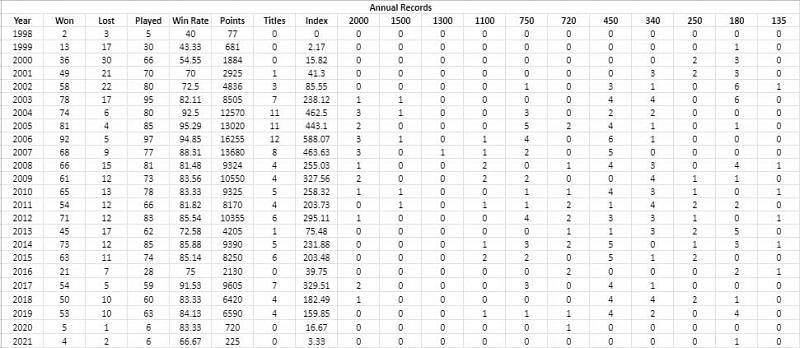
Roger Federer registered his highest index score in 2006 - 588.07. He won 92 matches that year, scoring 16,255 points and claiming 12 titles - all of which are career-best figures.
Only his win-rate of 95.29% was higher in a different year - 2005.
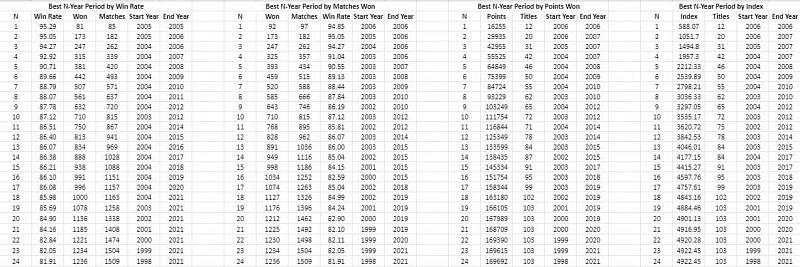
Roger Federer's best periods (made up of a given number of years, denoted by 'N') by points are mostly consistent with his best periods by index. But there are a few differences, the first of which was observed in his 11-year period.
While Roger Federer scored more points from 2004-2014, he has a higher index score from 2002-12. And that's primarily because of his 2003 Wimbledon title.
A deviation was again observed for his 14-year period. This time, Roger Federer scores more points from 2002-2015, but has a higher index score from 2004-2017. His incredible win-rate of 91.53% in 2017 compounds his one additional Grand Slam win, which leads to the higher index totals.
Rafael Nadal
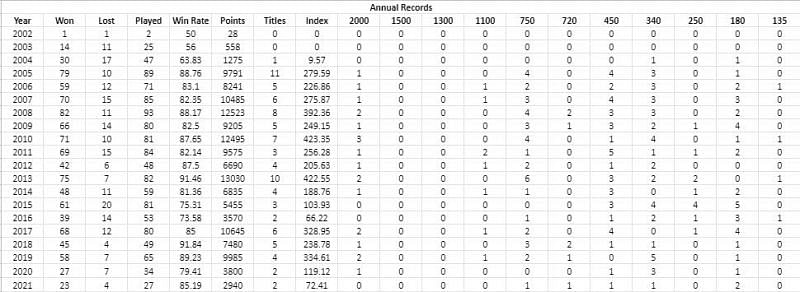
The consistency of Rafael Nadal's best years under various parameters is the polar opposite of Roger Federer's. While the Swiss' best results almost entirely center around 2006, Nadal has notched up his greatest success in years spread across a vast period, as mentioned in the very introduction of the article.
But with the index in place, 2010 emerges as Rafael Nadal's best year - with a score of 423.35.

Since Rafael Nadal's best year is so different under the various parameters, deviations naturally arise for his best two-year periods as well. But if we look past the one-year and two-year periods, the next difference between point-wise scores and index-wise scores is observed as late as in the 12-year period.
The Spaniard scored more points from 2006-2017 but has a greater index score from 2008-2019.
Understandably, the difference arises due to his three Grand Slam titles in the 2018-2019 period as opposed to only two in 2006-2007. Rafael Nadal's stand-out win-rate of 91.84% in 2018 is also a contributor.
The same factors also influence the difference in his best 13-year periods across the two categories.
Novak Djokovic

Like Roger Federer, there's little dispute over Novak Djokovic's best season. The Serb registered career-best numbers in every metric in 2015 - 82 matches won at a win-rate of 93.18%, 11 titles, 16,545 ranking points and an index score of 579.58.
Some fans believe 2011 was Novak Djokovic's best year because of the relative strength of the opponents he faced. But analysis of the opposition, or its weight in assessing a season, is beyond the scope of this article.

In Novak Djokovic's case, some major fluctuations were observed after his best seven-year period of 2010-2016. As we consider more years, Djokovic's point-wise best tends to include a pre-2010 season, while his index-wise best incorporates a post-2017 campaign.
Novak Djokovic, when he was younger, played and won more matches on the whole. On the other hand, his older version is more efficient.
Of course, that was the very idea that formed the premise of the study and the development of the index. It is only when we reach a large-enough timeframe that includes both 2007 and 2021, i.e. 15 years, that the results under the two parameters get stabilized.
Comparing the best N-year periods of the Big 3
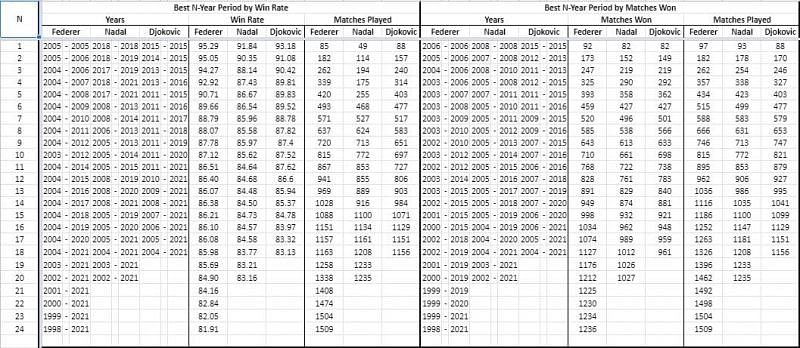
Considering the best stretch of years according to win percentage, Roger Federer's best figures over three years (94.27%) are greater than Novak Djokovic's best (93.18%). Similarly, the Swiss' best win-rate over four years (92.92%) is greater than Rafael Nadal's best numbers in a season (91.84%).
Roger Federer and Novak Djokovic match each other very closely as we increase the number of years. Rafael Nadal's win percentage, on the other hand, follows a peculiar pattern of increasing slightly when certain years are added. That is because the Spaniard's best years are separated by relatively average ones due to his injuries.
Roger Federer holds the edge in terms of the number of matches won as well. Novak Djokovic remains sandwiched in this category, lying mostly closer to Rafael Nadal.
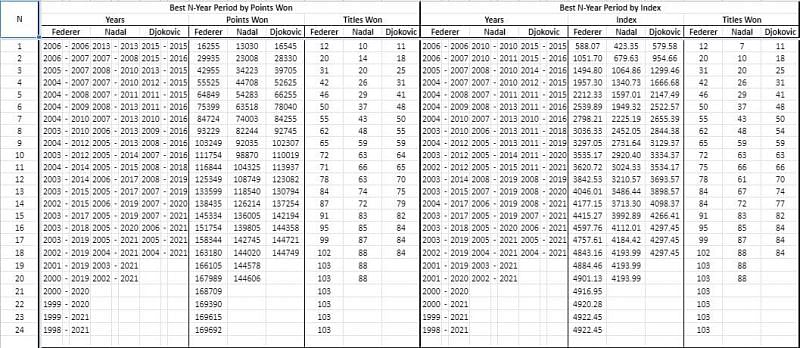
Novak Djokovic recorded the highest score by points over a calendar year (16,545 in 2015), while Roger Federer scored the highest by index (588.07 in 2006). Djokovic also scores the highest by points for the best 5-year and 6-year periods, while Federer does so for all the other durations.
Roger Federer leads in every N-year period when it comes to the index, while Novak Djokovic remains a close second all the way through up to his best 14-year period. Rafael Nadal, meanwhile, steadily narrows down the gap from the 12-year period onwards.
So who has been the most dominant among the Big 3 in specific time periods? Like most things about the trio, the numbers are closely matched. But Roger Federer and Novak Djokovic do seem to have a slight edge over Rafael Nadal, which can perhaps be attributed partly to Nadal's injuries.
As for who has been more dominant between Federer and Djokovic, it is up to each one of us to draw our own conclusions from the numbers.